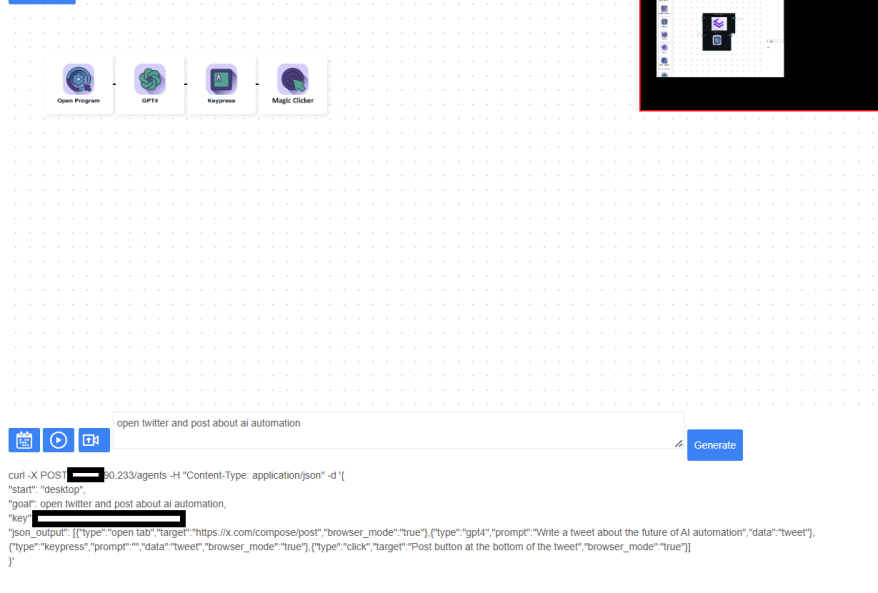The Agents API now runs on every Open Agent Studio instance. An easy way to test this is to run Ngrok locally, or use Open Agent Studio which publishes a public IP address you can use as your personal Agents API.
 The website editor now generates a sample curl request in simple english with the JSON API for you to test. You can install ngrok to run the Agents API locally if you add /agents to the end of the ngrok address like in the above image.
The website editor now generates a sample curl request in simple english with the JSON API for you to test. You can install ngrok to run the Agents API locally if you add /agents to the end of the ngrok address like in the above image.
 It even returns all the saved agent data during the automation, plus the verification testing loop steps we use to verify each action.
It even returns all the saved agent data during the automation, plus the verification testing loop steps we use to verify each action.
Key Concepts
Nodes: Individual actions an agent can perform
Variables: Data that can be passed between nodes
Verification: Checking if a node’s action was successful
Global Variables: Shared data accessible across all nodes
POST /agents
Creates and runs a new agent based on the provided JSON configuration.
Request Body
{
"key": "your_api_key",
"json_output": [
{
"type": "action_type",
"parameters": "action_specific_parameters"
},
...
],
"goal": "description_of_agent_goal"
}
Agent Node Types
Desktop+Browser Automation
Delay
Pauses execution for a specified time.
The time to pause in seconds
json { "type": "delay", "time": 5 }
The text to type or key to press
{ "type": "keypress", "prompt": "Hello, World!" }
Description of element to click in simple language
Set to true for browser-specific clicks
json { "type": "click", "target": "Submit button", "browser_mode": true }
json { "type": "open tab", "target": "https://www.example.com" }
Data Processing
GPT4
Uses GPT-4 for natural language processing.
json { "type": "gpt4", "prompt": "Summarize the following text:", "input": ["article_text"], "data": "summary" }
json { "type": "python", "code": "import pandas as pd\ndf = pd.read_csv('data.csv')\nprint(df.head())" }
json { "type": "bash", "command": "ls -la" }
Integrations
Google Sheets Create
Creates a new Google Sheet.
Variable to store sheet URL
Variable to store sheet name
json { "type": "google_sheets_create", "URL": "new_sheet_url", "Sheet_Name": "new_sheet_name" }
json { "type": "google_sheets_add_row", "URL": "sheet_url", "Sheet_Name": "sheet_name", "data": ["John", "Doe", "30"] }
Variable to store read data
json { "type": "google_sheets_read", "URL": "sheet_url", "Sheet_Name": "sheet_name", "data": "sheet_data" }
Variable containing additional data to append
json { "type": "email", "to": "[email protected]", "subject": "Monthly Report", "body": "Please find the monthly report attached.", "data": "report_data" }
Variable containing data to send
Variable to store response
json { "type": "api", "URL": "https://api.example.com/data", "headers": {"Content-Type": "application/json"}, "body": {"key": "value"}, "data": "request_data", "output": "api_response" }
Utility
Add Data
Loads data from various file types.
json { "type": "add_data", "target": "csv_data", "data": "/path/to/file.csv" }
Cron expression for scheduling
json { "type": "schedule", "cron": "0 9 * * 1-5" }
json { "type": "general", "description": "Search for the latest news articles about AI and summarize them" }
Description of data to scrape
Variable to store scraped data
json { "type": "semanticScrape", "target": "product reviews and ratings", "data": "product_reviews" }
json { "key": "your_api_key", "json_output": [ { "type": "open tab", "target": "https://example.com/products" }, { "type": "delay", "time": 5 }, { "type": "semanticScrape", "target": "product listings", "data": "product_data" }, { "type": "gpt4", "prompt": "Analyze the product data and summarize the findings", "input": ["product_data"], "data": "analysis_result" }, { "type": "google_sheets_create", "URL": "sheet_url", "Sheet_Name": "sheet_name" }, { "type": "google_sheets_add_row", "URL": "sheet_url", "Sheet_Name": "sheet_name", "data": ["analysis_result"] }, { "type": "email", "to": "[email protected]", "subject": "Product Analysis Report", "body": "Please find the latest product analysis attached.", "data": "analysis_result" } ], "goal": "Scrape product data, analyze it, save to Google Sheets, and email the results" }
- Use descriptive names for variables to make the workflow clear.
- Add appropriate delays between actions to allow for page loading.
- Handle errors gracefully by checking node verification results.
- Use GPT-4 nodes to add flexibility and intelligence to your agents.
- Leverage integrations like Google Sheets for data storage and sharing.
- When using the python node, ensure all necessary libraries are imported.
- For file operations in the add_data node, ensure file paths are correct and accessible.
- When scheduling agents with the schedule node, use correct cron syntax.
- For API calls, double-check URL, headers, and body parameters.
- Use the general node for complex actions that may require multiple steps.
By following this documentation, you can create sophisticated automated agents capable of handling a wide range of tasks across multiple platforms and services. The Agents API provides a flexible and powerful framework for defining complex sequences of actions, data processing, and integrations.  The website editor now generates a sample curl request in simple english with the JSON API for you to test. You can install ngrok to run the Agents API locally if you add /agents to the end of the ngrok address like in the above image.
The website editor now generates a sample curl request in simple english with the JSON API for you to test. You can install ngrok to run the Agents API locally if you add /agents to the end of the ngrok address like in the above image.
 It even returns all the saved agent data during the automation, plus the verification testing loop steps we use to verify each action.
It even returns all the saved agent data during the automation, plus the verification testing loop steps we use to verify each action.
